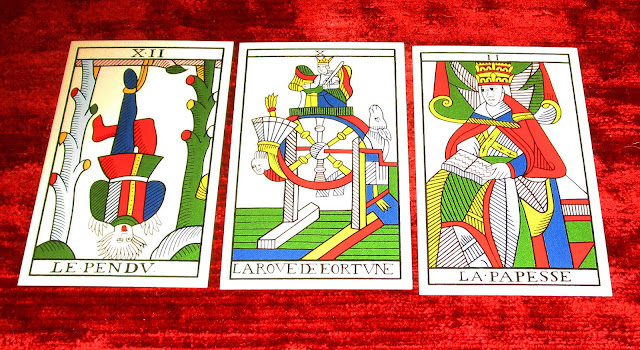HOODOO MAN (MEMPHIS AL)
by Albert Williams
My name is Memphis Al, and they call me the hoodoo man
My name is Memphis Al, and they call me the hoodoo man
Now if you want your fortune told,
you had better see me when you can
I do my crawlin' at midnight, don't be seen in the day
I do my crawlin' at midnight, don't be seen in the day
Well, you know whilst everything quiet and easy,
the hoodoo man can have his way
If you wanna see me, baby, you had better see me when you can
If you wanna see me, baby, had better see me when you can
'Cause you know I'm a very busy fellow,
and they call me the hoodoo man
Le Hoodoo Tarot de
Marseille is a standard 78 card
Marseille deck (e.g. a Noblet or Dodal) that has been ‘Pataphysically
re-imagined and re-configured (constrained) into a 33 card conjure inspired
hoodoo tarot.
The deck is a singular
exception to the normal Marseilles, an anomaly created by imposing a slight
swerve onto the protocols determining which cards may be allowed into the deck
(along with their new assigned meanings)…the nature of said swerve being
inspired by hoodoo belief and practice.
The resulting deck may be
read to good effect in several ways, two of which are as follows:
First, according to possible new meanings
assigned an individual card (when designated...see below) and/or traditional symbolic
meanings (in the case of the trumps whose meanings have not been re-defined) and/or, second, using an “open”, observational/intuitive "what's happening -
how does it make you feel" approach (a la Enrique Enriquez, Camelia Elias), or a combination
of both.
Potentially intriguing,
amusing and significant clinamen, anomalies, syzygies, antinomies and
conjurations may be observed, depending on the particular reading style(s)
employed. Observing the results of at least two reading styles for any given query is recommended for full effect.
Various spreads may be
used, of course, depending on the proclivities of the reader and querent.
A
significator, which is not one of the cards in the reading deck, may used to
represent either the querent or the object of the query and/or eventual spell
cast by the cards.
This significator is typically an ordinary playing card, an
“identifier” petition paper, or other small object, which the querent can take
with them when the reading concludes…to be used as either as a symbolic
reminder, continuing “prompt” of the reading…a talisman…or as a “casting”
delivered in some way to the object of the query or spell…i.e. the person or
thing the querent wants to either attract or repel.
The cards included in the
hoodoo deck are:
All of the Major Arcana,
some with newly delineated meanings as follows:
The Hanged Man – One who “turns the world upside down”, a genius,
an enlightened man…one “in the know”, a trickster.
The Pope – A powerful Hoodoo Man
The Popess – A powerful Hoodoo Woman
Force – Power, not “forcing” or just physical strength
Temperance – Calculating, measuring, scheming
The Hermit – A Man of Knowledge, enlightenment, not hiding
The Sun – “In the know”, exposed, awakened
The Court cards included
are:
The Queen of Cups – Healer, rootworker, healing, uncrossing, healed,
uncrossed
The Queen of Wands (Batons) – Witch (black magic), harming, crossing, harmed, crossed
The Valet of Coins – Trickster (like the Jack of Diamonds)
The Pips included are:
Ace of Cups – The Holy Grail, abundant blessings, mystical
union
Ace of Wands (Batons) – Sexual lust, dominance
Three of Cups – The Holy Trinity, salvation
The fives of all four
suits. The quincunx, or “five spot”
is an important number in hoodoo workings because it is a symbol of, and a
possible stand-in for, the crossroads…a sort of portable crossroads, when the
real thing is not available. In the Hoodoo Marseilles, if a five appears it
means the querent is at a crossroads…in matters of love if the Five of Cups, in matters of money and luck if the Five of
Coins, in matters of business
dealings, if the Five of Wands (Batons), and in matters of physical, intellectual or emotional conflict, if
the Five of Swords.
Nine of Wands (Batons) – Cast a spell. Nine is an important number in
conjure…write a name on a petition nine times, perform a working nine days in a
row (or some multiple), the timing of workings in graveyards or at the
crossroads, etc.
The number of cards in this
Hoodoo Tarot of Marseille is 33…3x3=9.
Additionally, the balance
of the cards may be used in the following manner to answer a “yes-no” question.
Shuffle the cards thoroughly, then cut the cards and turn the left half of the
deck face up.
If the card on top is
either Cups or Coins (corresponding to Hearts and Diamonds… the red cards in a
playing card deck), the answer to the querent’s question is Yes; if the card on
top is either Wands (Batons) or Swords (corresponding to Clubs and Spades…the
black cards in a playing card deck), the answer is No. The strength of either
the Yes or No may be gauged by the number of the card, with the two being the
lowest card and the Ace being the highest, as with playing cards.
It will be noted that there
is one fewer Yes cards than No cards because of the way that the suits are
deployed in the main body of the “working” deck. Using this method, the deck is
slightly “stacked” against a yes answer, so questions should be worded
accordingly, or one could simply remove a No card to even the odds.
Le Hoodoo Tarot de
Marseille may, of course, be
used for ‘Pataphysical spell casting for literal imaginary solutions (as
suggested, above), as well as the exposing of fictive truths (within the
literal and imaginary constraints imposed by the “experiment”).




















































